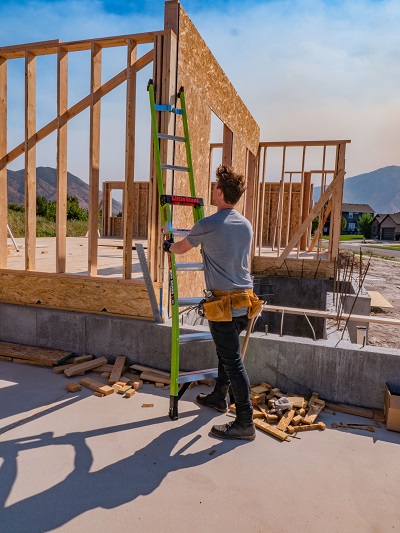I really thought we would have flying cars by now. Growing up watching cartoons like the Jetson’s or movies like Back to the Future, we were led to believe that everyone would be flying around with jetpacks and hoverboards. Unfortunately, no one has invented anti-gravity boots yet, so we still need tools like ladders to work at heights. Until someone finds a way to work around the laws of gravity, flying cars and preventing people from falling is something we will need to keep working on. Falls continue to be one of the leading causes of accident and injury, not only in the workplace, but also around the house.

Every year more than 300 people die in ladder-related accidents, and thousands suffer disabling injuries. We are proud to participate in the ALI’s annual National Ladder Safety Month to raise awareness of ladder safety in the home and in the workforce and to decrease the number of ladder-related injuries and fatalities. (The American Ladder Institute (ALI) is a not-for-profit association dedicated to promoting safe ladder use.)
National Ladder Safety Month is the only movement dedicated exclusively to the promotion of ladder safety at home and at work. During March 2019, National Ladder Safety Month will bring heightened awareness to the importance of using ladders safely through resources, training and a national dialogue. To get involved, you can join at www.laddersafetymonth.com.
The ALI will provide weekly email blasts covering topics like ladder safety at home, ladder inspections, prevention through design and the leading causes of ladder accidents and how to avoid them. They will also provide contact information to ladder safety professionals who will provide free on-site ladder safety training for your company or association.
Providing better ladder safety training is only part of the solution to reducing the number of ladder-related accidents and deaths. The other part is encouraging innovation in an industry and for a product that hasn’t changed much in hundreds of years. By designing safer products, we can prevent accidents from happening and get everyone home at the end of the day. Having safer products doesn’t do you any good if nobody knows they exist. Part of ladder safety training is choosing the right ladder for the job and being informed of new equipment available. Advances in technology have changed everything else in your life. It’s time we improve the ladders we trust our lives with.
In order to design a safer ladder, we need to study the ways people use their ladders and design them around or against human behavior. By dividing accidents into the three major causes, we can design solutions to each major problem.
1) Repeated Handling of Heavy Climbing Equipment
Strains and sprains caused by moving and setting the ladder are usually less serious, but because they are by far the most common kind of injury, they account for the greatest expense to the employer. By using modern advances in fiberglass-resin composites and engineering design, the weight of an extension ladder can be reduced by up to 25 percent without reducing its strength. Reducing the weight of the ladder, along with proper training, will greatly reduce this type of injury.
2) Using the Wrong Ladder for the Job
Using a ladder that is too short for the job, climbing on the top rung, or using a stepladder and leaning it against the wall like an extension ladder are prime examples of this mistake. This type of accident is usually more serious because it involves a fall that might result in broken bones or a permanent disability. Proper training is important to educate the user about proper ladder selection. Multipurpose ladders, which adjust to multiple sizes and configurations can also be used if needed.
3) Falls Due to Over-Reaching
Over-reaching leads to the most serious type of ladder-related injuries, often disability or death. Instead of climbing down and moving the ladder over a few feet, some users try to reach beyond the recommended distance and cause the ladder to tip. Uneven ground is also a factor in this type of accident. Just one inch out of level at the bottom of a 28-foot ladder will cause the top of the ladder to be more than 19 inches off center, vastly increasing the likelihood of a side-tip fall. Adding levelers to the ladder can help alleviate this concern, but levelers do not prevent the user from over-reaching. In addition, they add extra weight to the ladder and increase the possibility of a strain or sprain. Training everyone to keep their belt buckle between the side rails while working on a ladder will help. The best solution to the over-reaching problem is adding retractable wide-base levelers to greatly increase side-to-side stability. Since no jobsite is perfectly level, these outriggers also adjust to uneven ground to ensure a perfectly level base.
The ALI believes every ladder accident is preventable, but without better training and continuous innovation in safety planning and product design, we will continue to see far too many fatalities. Please join the American Ladder Institute and its members in sharing this message with the world. For more information, visit www.laddersafetymonth.com.
 Dave Francis has been in the ladder business for more than 30 years. As a college student, he cleaned the offices of Little Giant Ladder Systems at night and has stayed with the company ever since. Working his way up the ladder (pun intended), Dave became the Director of R&D and holds five U.S. patents for improvements in ladder design. He is now the National Safety Director, with the sole purpose of preventing ladder accidents and hopefully saving lives by promoting ladder safety training and innovations in ladder design. Dave Francis has been in the ladder business for more than 30 years. As a college student, he cleaned the offices of Little Giant Ladder Systems at night and has stayed with the company ever since. Working his way up the ladder (pun intended), Dave became the Director of R&D and holds five U.S. patents for improvements in ladder design. He is now the National Safety Director, with the sole purpose of preventing ladder accidents and hopefully saving lives by promoting ladder safety training and innovations in ladder design.
Dave has provided ladder safety insights to companies around the U.S., including The Walt Disney Company, Boeing, Comcast, and BP Oil. He is also the editor of www.LadderSafetyHub.com, a ladder safety blog. His goal is the same as yours—getting everyone home to their families at the end of the day. If you would like to get in touch with Dave, email him at dave@ladders.com. |
